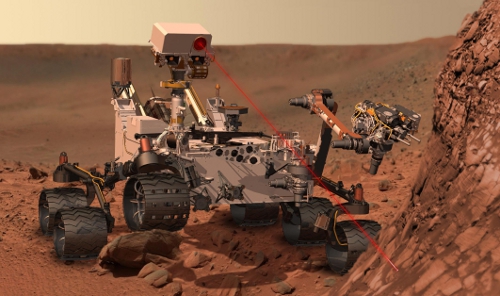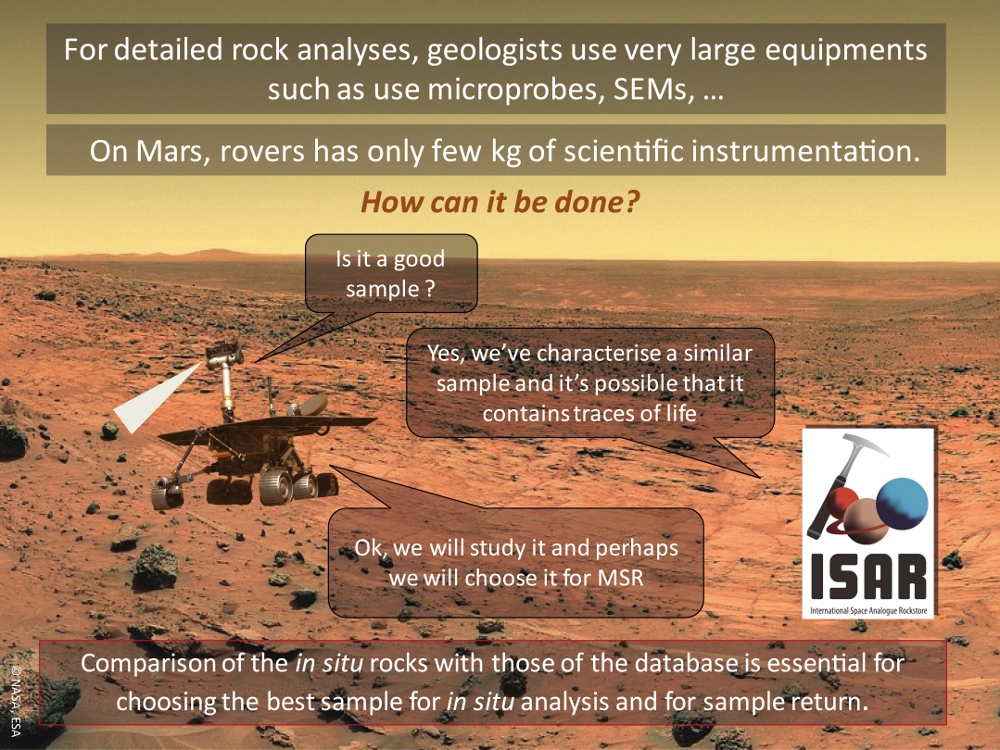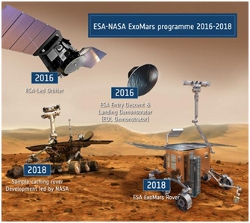Lastest News
Important update of ISAR databaseParticipation to IPPW 2017Participation to AbSciCon 2017 See allMy selection
Contact us
ISAR,
Frances Westall,
Frédéric Foucher,
Centre de Biophysique Moléculaire,
UPR CNRS 4301,
rue Charles Sadron,
45071 Orléans Cedex 2
France
Mentions légales
Objectives of the ISAR
Instruments for in situ missions to extraterrestrial bodies should ideally be cross-calibrated using a common suite of relevant materials. Such multi-instrument calibration would enable better comparison of instrument performances during the mission, as well as aid in the interpretation of the in situ measurements.
In view of the present mission MSL and of the upcoming 2020 ExoMars rover mission (see below for more details on the exploration of Mars), we are concentrating initially on materials of specific relevance to Mars. The initial collection includes basalts (ultramafic, mafic, andesitic, trachytic, rhyolitic, weathered, hydrothermally silicified); sediments (volcanic, marine, biolaminated, banded iron formations); and minerals (silicates, evaporites, clays, Fe-oxides). This set of samples is being continually increased. All samples have been characterised morphologically, petrologically, and geochemically using the types of analyses likely to be performed during an in situ mission: hand specimen description, optical microscopy, mineralogical analysis (XRD, Raman and IR spectrometry), and elemental analysis (EDX, electron microprobe, ICP-MS/OES).
Missions to Mars
Part I: Past and Present Martian Exploration
More than 40 missions have been launched to explore Mars. In what follows, we list the previous missions and instrumentation used to study the Martian geology and whose data are the basis of this project. After Viking 1 and Viking 2, launched by NASA in 1975 (more),scientists had to wait a long time (until 1996) for new observations of the geology of Mars.
The missions to Mars consist of two types: orbital and surface missions.
The orbital missions provide global mineralogical information. In 1996, the first probe after Viking to be launched to Mars was MGS (more). This NASA-JPL orbiter contained the Mars Orbiter Camera (MOC), the Mars Orbiter Laser Altimeter (MOLA) and the Thermal Emission Spectrometer (TES). This mission was essential for obtaining topographic maps of Mars. In 2001, NASA launched the Mars Odyssey mission (more),an orbiter containing the Thermal Emission Imaging System (THEMIS) and a Gamma Ray Spectrometer (GRS). The next mission, Mars Express, was launched by ESA in June 2003 (more). This probe contains a stereoscopic camera (the High Resolution Stereo Camera, HRSC), an infrared spectrometer (the Planetary Fourier Spectrometer, PFS), and an IR-spectro-imager called OMEGA (Observatoire pour la Minéralogie, l’Eau, les Glaces et l’Activité). NASA Mars Reconnaissance Orbiter, MRO more), launched in 2005. This orbiter has a High Resolution Imaging Science Experiment (HIRISE) providing high-quality images of the Martian surface, a Mars Color Imager (MARCI) for imaging the surface, and a Compact Reconnaissance Imaging Spectrometer to Mars (CRISM). Finally, ESA launched the Trace Gas Orbiter (TGO) as part of the ExoMars 2016 mission. The objective of TGO is to analyse atmospheric composition, in particular for methane that may be associated with biological processes. This probe will also act as a telecom relay for the ExoMars 2020 rover mission.
Surface missions include two types of space vehicles: landers and rovers. In July 1997, the first rover, Sojourner, a part of the Mars Pathfinder mission launched by NASA, landed on the Martian surface (more). This small rover explored its landing site, Ares Vallis, and studied rocks such as "Yogi", "Scooby Doo" and "Moe", using cameras and tools for elemental composition analysis e.g. the Alpha Proton X-ray Spectrometer (APXS). The next mission developed by the NASA was the MER programme (more), which launched in two phases in the summer of 2003. This mission had two rovers, Spirit and Opportunity. Spirit landed in Gusev crater and Opportunity on Meridiani Planum, both in January 2004. The twin rovers featured a mast with cameras (including a panoramic system), an arm with a Rock Abrasive Tool (RAT), an APXS, a Mössbauer spectroscope and a Microscope Imager (MI) for rock and mineral interpretation. An infrared spectrometer was placed on the top of the mast. Spirit continued operations until 2010, though Opportunity remains active at the time of writing (2017). Following these successes, the NASA Phoenix mission (more)was landed in Vastitas Borealis near the Martian North Pole in 2008, where the lander observed traces of water ice and carbonates. The last mission to be landed by NASA, in 2012, was MSL (more), with the rover Curiosity. This rover is really a geologist on wheels! It is fitted with different cameras (MastCam on the mast, and a microscopic camera Mars Hand Lens Imager, MAHLI, on the arm) and various mineralogical and geological instruments, such as Laser Induced Breakdown Spectroscopy (LIBS, on ChemCam), X-ray diffraction and fluorescence (XRD and XRF), an APXS and the Sample Analysis at Mars (SAM) facility for analysing organic molecules. All these probes, except Phoenix, landed in the equatorial regions.
MSL has the following science objectives:
- Biological objectives:
- (i) Determine the nature and inventory of organic carbon compounds;
- (ii) Inventory the chemical building blocks of life (carbon, hydrogen, nitrogen, oxygen, phosphorous, and sulfur);
- (iii) Identify features that may represent the effects of biological processes.
- Geological and geochemical objectives:
- (i) Investigate the chemical, isotopic, and mineralogical composition of the martian surface and near-surface geological materials;
- (ii) Interpret the processes that have formed and modified rocks and soils.
- Planetary process objectives:
- (i) Assess long-timescale (i.e., 4-billion-year) atmospheric evolution processes;
- (ii) Determine present state, distribution, and cycling of water and carbon dioxide.
- Surface radiation objective:
- Characterize the broad spectrum of surface radition, including galactic cosmic radiation, solar proton events, and secondary neutrons.

Part II: Future Martian Exploration
In 2001, the ESA initiated the Aurora program, a long-term plan for robotic and human exploration of the solar system, in particular on Mars, and for the search for extraterrestrial life. The first step of this exploration is the ExoMars mission (more). ExoMars had been redefined several times since the beginning of the project, in particular for financial reasons. In its present version, the mission will be financed jointly by ESA and Roscosmos, the Russian space agency. This 2020 mission to Mars has a number of scientific objectives, which are listed below in order of priority:
- (i) the search for possible biosignatures of past or present life;
- (ii) the characterisation of the water and geochemical distribution as a function of depth in the shallow subsurface;
- (iii) the study of the surface environment;
- (iv) the investigation of the planet's subsurface and deep interior in order to better understand the evolution and habitability of Mars;
- (v) the achievement of incremental steps ultimately culminating in a sample return flight.
The first part of the mission was the launch of both the Trace Gas Orbiter (TGO) and the Descent and Landing Demonstrator Module (EDM) in 2016. The EDM was intended be a static lander studying the dust in the atmosphere during decent and make several meteorological measurements on the surface, but did not make a soft landing on Mars. The second part of the mission will be the launch of a rover in 2020. The advance of this rover over previous missions will be a drill capable of reaching a depth of up to 2 metres. In addition to the drill, the ExoMars 2020 rover will include a camera (PanCam) and long-range infra-red spectrometer (ISEM) on the mast, a ground-penetrating radar (WISDOM), a high-resolution close-up imager similar to a geologist’s hand lens (CLUPI), a tool to search for subsurface water and hydrated minerals (ADRON), a laser desorption GC-MS (MOMA), and two infra-red spectrometer (Ma_MISS and MicrOmega-IR) and one Raman spectrometer (RLS) for mineralogical study. Simultaneously, NASA will launch the Mars 2020 rover with similar astrobiological goals. It features a stereoscopic camera (Mastcam-Z) and long-range instrument for chemical composition and mineralogy (SuperCam), X-ray fluorescence imaging spectrometry (PIXL), a ground-penetrating radar (RIMFAX), and a Raman spectrometer (SHERLOC). The characterisation of the ISAR collection has been conducted with these mission-specific techniques in mind, and produces a comparable dataset that we might consider in light of that obtained in situ on other Solar System bodies.
Missions to other bodies
Presently, the sample selection for the ISAR is focussed on the future Mars missions. However, depending upon the destinations of future ESA and NASA missions, further relevant samples will be added.
EURO-CARES
The ISAR team is also involved in the European Curation of Astromaterials Returned from Exploration of Space (EURO-CARES) project, which endeavours to develop a roadmap for a European Sample Curation Facility for samples brought back to Earth during future space missions. ISAR is particularly pertinent to EURO-CARES Work Package 5: analogue samples as proxies for extraterrestrial materials. To find out more about the EURO-CARES project, visit www.euro-cares.eu or WP5 website for more information about analogue samples.













